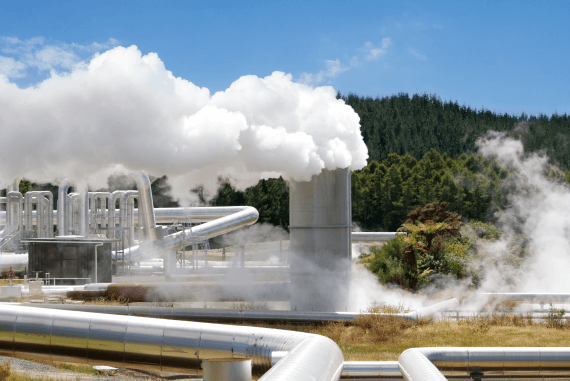- Home ››
- Health and Safety Training ››
- Environmental Health and Safety ››
- Energy ››
- Geothermal
Geothermal Energy
Introduction
In many regions of the world, in particular those around tectonic plate boundaries where volcanoes are prevalent, the ground is hot because of the presence of magma much closer to the earth's surface than in other locations. This heat is put to good use in many different ways, such as cooking meat on a BBQ at Timanfaya Park in Lanzarote. As well as humans, other creatures also harness the heat energy from just below the surface for their own needs, like Scrubfowl birds who bury their eggs in the warm ground rather than having to constantly sit on them to keep them warm like other species of birds need to do.
What is Geothermal Energy?

Geothermal energy is a renewable form of natural energy. There are three slightly different types of geothermal power plants which use a different method to generate/harness steam needed to spin a turbine and produce electricity.
A dry steam geothermal power plant will take water close to the surface that has already been heated to such a temperature in the earth that it has turned to steam. This steam then spins a turbine as it escapes. This is one of the earliest and simplest forms of harnessing geothermal energy to produce electricity, but it relies on finding water which has already been heated hot enough to produce the steam.
A flash geothermal power plant draws hot water from the ground under high pressure into a tank at the surface which is of a much lower pressure. When the two mix, the water vaporises into steam which drives the turbine.
A binary geothermal power plant takes hot water from the ground. It is fed to a heat exchanger, where its heat is used to raise the temperature of another liquid such as isopentane which boils, and therefore turns to steam, at a lower temperature. This steam drives the turbine, and then condenses back into liquid form to be re-used. A nice moving diagram of this process can be found here.
Geothermal Energy is Not Just Used for Generating Electricity
We saw in the opening paragraph of this article how the heat from the ground can be used directly, rather than having to generate electricity to power a process or piece of equipment.
Outside of volcanic regions, the temperature of the earth when digging down is remarkably consistent and constant no matter what the season. This means that when the air temperature is cold, the heat from the warmer ground can be used to heat a building. When the air temperature is hot, the heat can be transferred to the cooler ground.
Geothermal heat pumps draw water through a loop of pipes under the ground. When the outside air temperature (and therefore the rooms of the building) is cold, water is heated in the pipe by the warm ground, which is then fed into the house and circulated around the building to radiate the warmth. In hot weather, the system can be run the other way, so that heat is taken out of the building and radiated into the ground around the pipes.
Heating a property in this way eliminates (or at least lessens) the need for consuming electricity. This electricity is likely to have been generated through the burning of fossil fuels that are highly detrimental for the environment in terms of pollution and harmful gases such as carbon dioxide that are given off.
Although they are both similar in terms of using the temperature of the ground, the two are quite different. Geothermal heat pumps are usually small scale, only heating and cooling one room or building directly, whilst geothermal energy relates to creating electricity by using heated steam to spin turbines. This is typically done on a large scale to provide power for many homes and businesses in the region.
Disadvantages of Geothermal Energy
Geothermal energy is similar to other forms of renewable power in that there are often high initial costs whilst the system is constructed and installed, but will then provide energy at relatively little cost as the input fuel is provided by nature for free. This large initial expense can often be off-putting for many, either because they simply cannot afford the large outlay or because they fail to foresee the long-term, bigger picture cost savings that will come as time goes by.
One environmental issue is that geothermal wells and boreholes will often release gases such as methane into the atmosphere which can damage the ozone layer and cause health implications for living creatures down on the earth. However, the amount actually released will generally be far lower than emissions from burning fossil fuels. Overall, geothermal energy is therefore much more preferable for the environment when it comes to energy and power generation than a fossil fuel power station could ever be.
Disadvantages of Geothermal Heat Pumps
Geothermal heat pumps work best in areas of the world that do not suffer from extreme temperatures. In polar regions for instance where the temperature is significantly below freezing for large periods of time, the water heated purely by a pipe running underground may never get hot enough to bring the room up to a comfortable temperature. Even so, it can always be used in addition to electrically-powered heaters, meaning that these electric heaters do not need to be operated for anything like as long or at high temperature as they would if they were doing all of the heating by themselves.
There may be additional costs in making an existing building's heating system compatible with a geothermal heating system, particularly as it will work far better if each room has underfloor heating pipes rather than single radiators.
Also, with any equipment and components which are buried either under the ground or underwater, maintenance and repairs can be much more difficult, time consuming and expensive than they would be if they were above ground and much more accessible.
Conclusion
Whether it is heat from volcanic activity, or natural ground heat caused by heating from the sun, the earth itself can provide a constant, renewable source of heat that can be tapped in to. Even if it cannot provide all of a building’s energy requirements (although in a lot of cases it can), it can still be used to significantly reduce the need for fossil fuel-powered heating or cooling systems, which will benefit the environment greatly.

